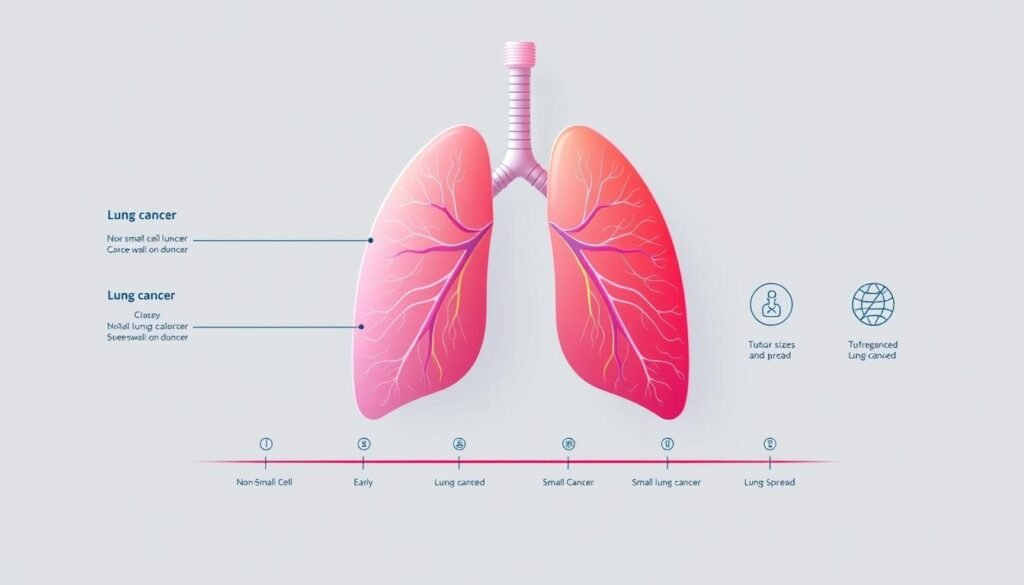Lung cancer causes about 20.4% of all cancer deaths in the U.S. It mainly hits older adults, with the average age at diagnosis being 70. The outlook might seem bleak, but recent research has improved survival chances for those with lung cancer. Knowing how survival rates differ by age is key to understanding lung cancer’s effects.
Survival rates change a lot. They depend on the person’s health, the lung cancer type, its stage when found, and the treatment used. All these factors influence what comes after a lung cancer diagnosis.
For more details, like how stages of lung cancer affect survival rates and treatment options, check out this detailed guide.
Key Takeaways
- Lung cancer represents 20.4% of cancer deaths in the U.S.
- The median age for diagnosis is 70 years, highlighting the age-related risks.
- Survival rates vary significantly based on age, type, and stage of lung cancer.
- Overall health and comorbidities are critical factors impacting survival.
- Advanced treatment options are enhancing prognosis for lung cancer patients.
- Understanding survival trends aids in the management of lung cancer effectively.
Introduction to Lung Cancer and Its Impact
Lung cancer is a major health problem. It’s the top cause of cancer deaths worldwide. In the U.S., it’s the second most common cancer for both men and women. Around 234,580 new cases of lung cancer are expected in 2024. Sadly, it’s estimated that 125,070 people will die from it. These numbers show how big of an impact lung cancer has on society.
The average age for lung cancer diagnosis is about 70. Most cases are in people 65 and older. Survival rates have gone up by 26% in the last five years. But, lung cancer still causes 1 in every 5 cancer deaths. This tells us we must raise awareness and push for early detection.
Non-small cell lung cancer makes up 80%-85% of cases, with small cell lung cancer at 10%-15%. This difference shows the need for treatments that fit each patient. Screening has become key in fighting lung cancer. It might lower death rates from the disease by up to 20%.
Understanding Lung Cancer Types and Stages
Lung cancer is mainly categorized into non-small cell lung cancer (NSCLC) and small cell lung cancer (SCLC). About 80-85% of cases are NSCLC, and 10-15% are SCLC. NSCLC patients usually have better survival rates, highlighting the importance of early detection.
The American Cancer Society identifies three principal lung cancer stages: localized, regional, and distant. The localized stage means cancer is only in the lungs. The regional stage shows it has reached nearby lymph nodes. And the distant stage means the cancer has spread to other body parts.

The stage of lung cancer at diagnosis greatly affects survival chances. For example, localized NSCLC has a 60% survival rate. But it drops to 6% for advanced cases. SCLC shows a decrease from 29% at a localized stage to 3% when distant. This shows why detecting lung cancer early is vital.
Understanding the different forms of lung cancer and their stages is crucial. It helps patients and doctors make informed treatment choices. This knowledge also aids in predicting how patients might fare.
The Importance of Age in Lung Cancer Prognosis
Age is key in determining lung cancer outcomes. As people get older, they face more issues from the disease. Studies show that older folks usually have more advanced lung cancer. This affects their chances of surviving.
There’s a big difference in survival rates based on age. For example, a study found a 67.3% one-year survival for younger patients. But, it was only 42.5% for older patients. This shows how age impacts health and how well treatments work.
The main lung cancer in young people is non-small-cell lung cancer (NSCLC), especially adenocarcinoma. Out of 3,481 patients, 92.3% under 45 had NSCLC. In older patients, 87% had the same type of cancer. This shows the need for treatment plans that consider age.
Many patients, young and old, have advanced lung cancer when diagnosed. With 98% in young and 92% in old patients. This highlights the need for better screening and early detection for everyone.
Also, older patients often don’t get the right cancer treatments. Only 71.8% of those over 80 got treatment, versus 93.2% under 60. Not getting treatment raises the risk of dying, especially with advanced cancer.
To wrap up, age strongly links to lung cancer survival. As people age, their outlook gets worse. This shows the challenges older patients face with lung cancer. Knowing these differences helps target healthcare better to each age group’s needs.
Lung Cancer Survival Rate by Age
Lung cancer survival rates vary by age, showing big differences in outcomes. Nearly 45% of people live for at least one year after diagnosis. However, this number falls to about 20% over five years. This change shows why it’s crucial to know survival rates for different age groups.
Statistical Overview of Survival Rates
Younger patients usually have better chances of beating lung cancer. For example, those diagnosed at stage 1 have a 65% chance of living five more years. But this chance decreases to 40% for stage 2 patients. For stages 3 and 4, the rates drop to 15% and 5%, respectively. Early detection saves lives, more so for the young.
The age-related differences in outcomes highlight the importance of awareness. To learn more, visit this guide on life expectancy and lung.
Variability Across Different Age Groups
Adults under 60 have better lung cancer survival rates than older people. Younger patients live about 20 weeks longer than older ones, on average. Age, health, and diagnosis stage matter a lot in survival chances. Knowing this helps in making health decisions.
Young adults with lung cancer show promising survival rates, underlining the need for more research and better treatments.

Factors Influencing Survival Rates
Many things affect how well lung cancer patients do. Overall health is key, especially with other illnesses like heart disease or diabetes. Older folks often have more health problems, which can make their outlook worse. How we treat lung cancer is also vital. Different treatments work differently for each age group.
Overall Health and Comorbidities
A patient’s overall health deeply affects their lung cancer survival. Having conditions like diabetes or heart problems can make fighting cancer harder. Elderly patients face tougher battles, reducing their survival chances. Research in India showed older patients have shorter survival times than younger ones. It’s crucial to understand these factors affecting lung cancer survival to customize care and improve outcomes.
The Role of Treatment Options
Treatment choices are a big deal for lung cancer patients’ survival. Younger patients usually do better with treatments like chemotherapy than older patients. Older patients often have a harder time dealing with chemotherapy’s effects. Their response to chemotherapy is usually not as good. This means treatments need to be tailored to the patient’s age. Considering a patient’s overall health is essential in choosing the right treatment. The various treatment options and how patients react can greatly change lung cancer results, based on age.
| Factor | Elderly Patients | Younger Patients |
|---|---|---|
| Median Survival Time | 37.8 weeks | 57 weeks |
| 1-Year Survival Rate | 42.5% | 67.3% |
| Respone Rate to Chemotherapy | Lower | Higher |
| Incidence of Anemia | Higher | Lower |
Survival Rates for Lung Cancer by Age Group
Lung cancer survival rates are different for each age group. This difference is especially challenging for older patients. They often see different outcomes compared to younger adults.
Statistics for Elderly Lung Cancer Patients
The survival rates for older lung cancer patients show a big contrast with younger ones. Those 70 and older usually live about 37.8 weeks after being diagnosed. This shorter time is due to age and health issues they already have.
| Age Group | Median Survival Time |
|---|---|
| 70 to 74 | 37.8 weeks |
| 75 to 79 | 37.8 weeks |
| 80 to 84 | 37.8 weeks |
| 85+ | 37.8 weeks |
Survival Trends in Younger Adults
Younger lung cancer patients have better outcomes. Those between 15 to 59 years old can live more than 57 weeks after finding out they have cancer. They respond better to treatments. New ways to find and treat cancer early help them even more.
| Age Group | Median Survival Time |
|---|---|
| 15 to 19 | 57+ weeks |
| 20 to 24 | 57+ weeks |
| 25 to 29 | 57+ weeks |
| 30 to 34 | 57+ weeks |

Prognosis of Lung Cancer Based on Age
Lung cancer prognosis varies greatly with the patient’s age. Older adults are more likely to be diagnosed at advanced stages. This is because symptoms are harder to spot early on. As a result, older patients have lower survival rates compared to younger ones. The differences in prognosis by age are quite clear and troubling.
Differences in Disease Stage at Diagnosis
Younger patients, under 60, often catch their cancer earlier. But, many older folks are diagnosed at later stages. This makes their treatment harder and less likely to succeed. A lot of older patients end up with metastatic lung cancer, which lowers survival chances. Treating lung cancer must take into account how age affects disease progression and treatment.
Impact of Treatment Responses by Age
The age of a patient affects how well they respond to treatment. For example, older patients don’t do as well with chemotherapy as younger individuals do. The median survival for older patients is about 37.8 weeks. For younger ones, it’s closer to 57 weeks. Also, younger patients have a one-year survival rate of 67.3%, while it’s only 42.5% for older ones. Understanding these differences can help improve lung cancer treatments for everyone. For more detailed information, check this analysis of lung cancer metastasis patterns and survival.
The Relationship Between Age and Lung Cancer Life Expectancy
Lung cancer life expectancy varies greatly with age. This is especially true for older adults. Most people diagnosed are around 70 years old. Those aged 65 and older generally see lower life expectancies upon diagnosis.
Despite medical advancements helping all ages, older adults still face a tough prognosis. For example, people over 60 typically live about 37.8 weeks after diagnosis. In contrast, younger patients may live up to 57 weeks. This gap shows how hard older adults are hit by lung cancer.
With age, surviving lung cancer gets harder. For those with metastatic small cell lung cancer, the 5-year survival rate is only 3%. Non-small cell lung cancer (NSCLC) offers slightly better chances, with an 8% survival rate. This reality shows a sharp decline in both the quality and length of life for older patients.
- Overall 5-year survival rate for lung cancer is about 18.6%.
- Age impacts the stage of cancer at diagnosis, affecting treatment outcomes.
- Black patients encounter higher lung cancer mortality rates compared to other groups.
Spotting lung cancer early is key to better survival rates. Early-stage cancers are easier to treat effectively. As people learn more about symptoms and risks like smoking, we can hope for improved outcomes. It’s important for older folks to be especially watchful for these signs.
Elderly Lung Cancer Survival Rates: A Closer Look
An in-depth look into elderly lung cancer survival rates shows alarming issues. Many patients, age 70 or older, face lower survival rates of about 42.5%. They are more at risk for complications during treatment. This affects their fight against the disease.
Their life expectancy, health, and how they respond to treatment are vital. These factors dictate their chances of beating cancer. Thus, it’s important to understand these aspects for better care.
In the U.S., life expectancy has increased from 49 in 1900 to 78.7 today. This has led to more lung cancer cases in the elderly. About 68% of patients are diagnosed after turning 65. This shows a need for special care for them. The highest number of lung cancer cases is seen in people 45 to 49. It peaks at 80 to 89 for males and 70 to 79 for females.
Table 1 highlights how survival rates for lung cancer change based on the disease stage at diagnosis. It shows how age affects a person’s chance of surviving.
| Type of Lung Cancer | Localized Survival Rate | Regional Survival Rate | Distant Survival Rate | Overall Survival Rate |
|---|---|---|---|---|
| Non-Small Cell Lung Cancer | 65% | 37% | 9% | 28% |
| Small Cell Lung Cancer | 30% | 18% | 3% | 7% |
Older adults often have fewer treatment options, which is worrisome. Many over 80 don’t get treated, lowering their survival chances. However, studies show elderly patients can undergo surgery like lobectomy without major risks. This is good news compared to younger patients.
New treatments are making a difference for older lung cancer patients. Targeted therapies and SBRT are promising. They often result in similar outcomes to younger patients. This underlines the need for care that suits the elderly’s unique health needs.
Conclusion
The study of lung cancer survival rates shows how age and gender affect patient outcomes. Younger patients usually have a better chance of surviving. Older adults often struggle because their disease is more advanced and they have other health issues.
The overall 5-year survival rate is 17.9%. This points out the urgent need for treatment plans tailored to each patient’s age. These plans can help people live longer.
Especially, younger people and women with adenocarcinoma tend to do better. Ongoing research is key to developing successful treatments. Studies like this one play a big role. They show that getting treated quickly can greatly improve chances of survival in lung cancer cases.
To sum up, progress is being made in treating lung cancer. But, more work is needed to help everyone, no matter their age or gender, get the care they need. By focusing on research and personalized care, we can improve lung cancer survival rates worldwide.